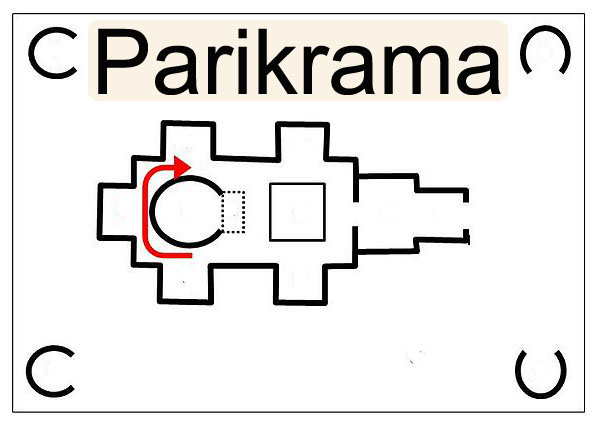Benefits of Parikrama

Parikrama is the devout perambulation or Pradakshina around a sacred and holy spot. This is either a mountain peak, a sacred Tirtha, a place of pilgrimage, or an entire area regarded as holy and sanctified by tradition. This practice of making a circuit is ordinarily done at any time and especially undertaken by devotees en masse at particular periods during the year.
When done on a smaller scale within a small ambit as round a Murti installed in a shrine, round the sacred Tulsi plant or Pipal tree, the perambulation is in common parlance termed ‘Pradakshina.’ A Parikrama also doubtless constitutes Pradakshina, but by convention, it is come to refer mainly to the big circuit.
More difficult forms of Parikrama are in vogue. Additional measures involving greater physical exertion and strain are combined with Parikrama. Some lay fully stretched upon the ground and roll along over the entire route. Some others proceed slowly prostrating full length at every three or ten steps. Others walk step by step, placing one foot in close proximity to the other and covering the whole distance of Parikrama. While others do the circuit themselves gyrating in a continuous Atma-Pradakshina.
All these difficult features are adopted by devotees at times as special penance, or in accordance with some vow previously made, or as a spontaneous expression of their zeal or fervor. Your mental attitude and motive will bestow on you the highest, maximum spiritual good.
Undaunted Yatris in the icy Himalayas do the difficult Parikrama of Mount Kailas and even longer circuit of Lake Manasarovar. Other Yatris complete a round of the entire Uttarakhand, in doing the Kedar-Badri-Yatra by going via one route and returning via another, after circling the Chardham.
Far off in the South, pious devotees make Pradakshina of the holy Arunachala at Tiruvannamalai. Rama Bhaktas and Krishna Premis go round Chitrakuta Parvata, Ayodhya, Brij, Brindavan, Govardhana, and Badrinath.
The deep significance of Parikrama lies in the fact that the devotee considers not the physical aspect of the place, hill, or Tirtha, but the spiritual power it symbolizes and the Divine Presence that is manifested and felt through it. Through the Lord’s revelation in the tenth chapter of the Bhagavad-Gita, you will understand how much special places are saturated with the Divine Presence.
By the fervent attitude of faith and veneration, you make yourself fully receptive to the inflow of the spiritual vibrations of the holy place. These powerful spiritual currents enter and purify all the sheaths, gross and subtle, destroying bad Vasanas and Samskaras. Tamas and Rajas are reduced. The concentrated influence of Sattva awakens dormant spiritual tendencies. By Parikrama, the devotee drinks deep the Divine atmosphere pervading the place and comes out of this spiritual path steeped in Sattvic vibrations. This is the inner working and significance of doing Parikrama.
Being a great purifier, it is enjoined on all devotees as a method of penance or Tapascharya by wise tradition and convention. It is an act of great spiritual benefit and religious merit too. The devotee takes bath, wears clean clothes, smears Tilak or sacred ash, and wears Tulsi or Rudraksha Mala and starts with God’s name on his lips. On the Parikrama route, you gain valuable Satsanga by meeting Sadhus and Sannyasins living there. Your sins are destroyed by taking bath in sacred rivers (on big Parikramas) or ponds and Kunds. You are elevated and blessed by Darsana of many holy shrines situated on the way.
You develop patience and endurance by putting up with various discomforts in the sun or rain or cold. Difficult Parikramas means giving up many dear articles to which the mind is attached. You have your mind freed from all thoughts and you are absorbed in the one idea of the Divine presence. A devoutly conducted Parikrama constitutes in one single act a triple Sadhana elevating your body, mind, and spirit.
The spiritual vibrations of the holy places of pilgrimage and shrines purify your base Asuric Vrittis and fill you with Sattva and purity. You need not go in for Satsanga. Mahapurushas come to you of their own accord. They are always in search of real and sincere Sadhakas. Therefore, they also remain in holy places like Badri, Kedar, Kailas, Hardwar, Brindavan, Mathura, etc.
Blessed indeed are those who take part in Parikrama, because they will soon attain peace, bliss, and immortality. Glory to Lord Rama, the Lord of Ayodhya! Glory to Krishna the Indweller of all hearts, whose special seat is Brindavan! Glory to Bhaktas! May their blessings be upon you all!
Source: dlshq.org






